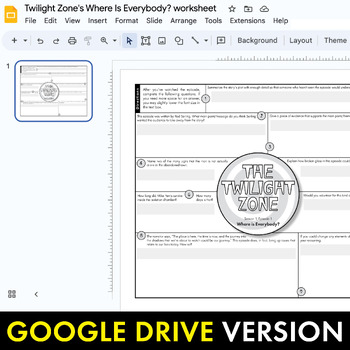Twilight Zone “Where is Everybody?” Media Analysis of Twilight Zone Episode CCSS
- PDF
- Google Apps™

What educators are saying
Description
There’s a reason Rod Serling’s series, The Twilight Zone, has stood the test of time. The stories are compelling, the episodes are well-crafted, and the themes are timeless. With this lesson download (PDF & Google Drive versions), you can also use The Twilight Zone to help students develop analysis skills and connect classic storytelling to modern issues.
In this “Where is Everybody?” episode, a man with amnesia finds himself trapped in an abandoned town. Issues of social isolation and the limits of technology to meet the basic human need for companionship will certainly get students talking about their own COVID-related experiences.
The video is about 24 minutes long and the worksheet completion will take about 15-to-30 minutes, depending on how much time you allow for discussion. Works great as a standalone lesson, sub plan, or supplement to a larger unit on a similar theme.
On my last product update, this episode was available to Paramount+ subscribers. It can be purchased via Amazon Prime and YouTube. This download also includes a link to an open-access website where the episode is being streamed with ads.
Want more activities like this one? Click here to scroll through my entire collection of video-based lessons: https://www.teacherspayteachers.com/Store/Laura-Randazzo/Category/Video-Based-Lessons-496064
Want your classes to learn more about Rod Serling, the writer/creator of The Twilight Zone series? Click here for a student-led research activity:
Want this item plus a whole lot more? Check out my Short Story Unit for Older Teens, a collection of stories and lesson materials designed specifically for high school juniors and seniors. You'll save more than 30% off the cost of those individual items, including the item featured on this page, if you purchase the bundle available here:
Hope you and your students enjoy this Twilight Zone activity. Thanks for stopping by!
Image credit: Pixabay, Public domain





